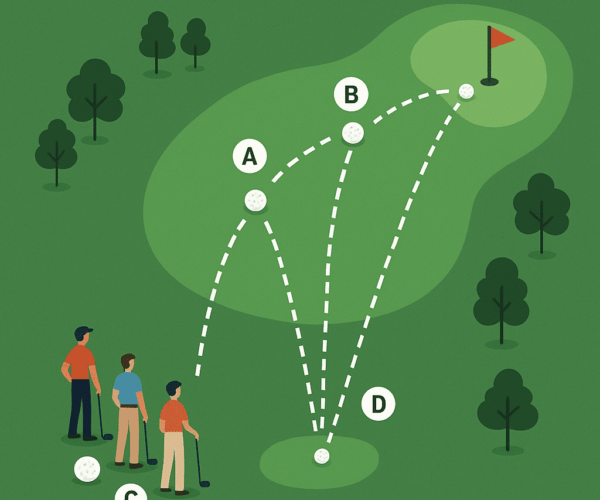If you’re a regular at your local club or simply enjoy a relaxed day on the course with friends, Texas Scramble might just be the perfect format for you. It’s a sociable, team-based way to play golf that blends strategy, camaraderie, and plenty of good-natured banter – and it’s becoming more and more popular across the UK.
Golf comes in all sorts of formats, from traditional stroke play to foursomes and match play, but some days, especially when your individual game just isn’t clicking, a format like Texas Scramble offers a welcome change of pace. It’s ideal for those rounds when you’d rather share the highs and lows with teammates than grind it out on your own.
Whether you’re completely new to the format or just need a refresher ahead of your next club comp, society day or charity event, this guide will cover everything you need to know to play and enjoy, a great game of Texas Scramble.
What is Texas Scramble?
Texas Scramble is a team-based golf format where each player hits a shot, and the team then chooses the best one. From that spot, all players hit again. This continues until the ball is holed. The aim is to complete the round in as few strokes as possible – but as a team, not individually.
It’s a format that’s particularly popular on golf days, corporate events, and social tournaments because it’s inclusive and forgiving, especially for higher-handicap players. Unlike stroke play or match play, the pressure is shared, and bad shots are easily forgotten if someone else comes up trumps.
How do you play Texas Scramble?

If you’ve ever watched a group play scramble and wondered what on earth was going on with everyone playing from the same spot, don’t worry — the format’s actually very straightforward once you get the hang of it.
The beauty of Texas Scramble rules lie in simplicity: all players contribute, but the team always plays from the best-positioned shot. This means fewer lost balls, better scoring opportunities, and a more relaxed pace — all while still requiring solid teamwork and decision-making. Here’s how it works in practical terms:
Team Setup
- Teams are usually made up of two to four players.
- Four-ball teams are most common for club or society events.
- Mixed teams (different abilities, genders or ages) are often encouraged.
Basic Rules
- Every player tees off on each hole.
- The team selects the best shot – known as the ‘chosen ball’.
- All players then play their next shots from that same spot (placing or dropping within a defined area, typically one club length or a scorecard’s length).
- Repeat this process until the ball is holed.
- Keep score as a team – it’s strokeplay, not matchplay.
- Some competitions require a minimum number of drives to be used per player to ensure everyone contributes.
It’s a blend of strategy and fun – do you go with the safe option or take a riskier shot for a bigger reward?
Example of play
Picture this:
- Four players – let’s call them A, B, C and D – all tee off on a par 4.
- B hits the best drive, right down the middle. The team chooses that ball.
- All four players pick up their own balls and walk to B’s ball, placing theirs within a small distance of it.
- They all hit their second shot from that position.
- A sticks it close with a wedge – they pick this shot.
- From there, they all putt – and D sinks it.
That’s one hole done, and hopefully a birdie on the card. Simple, strategic, and very satisfying when it all comes together.
Handicap calculations for Texas Scramble
One of the most common questions is, “How do you work out a team handicap?”
There’s no single universal answer, but a commonly used UK method is to apply a percentage of each player’s handicap, based on ability, and add them together for a team total.
The standard formula for four players:
- 25% of the lowest handicap
- 20% of the second lowest
- 15% of the third
- 10% of the highest
Example:
Let’s say your team handicaps are: 4, 10, 16 and 22.
Your team handicap would be:
- 25% of 4 = 1
- 20% of 10 = 2
- 15% of 16 = 2.4
- 10% of 22 = 2.2
Total team handicap = 7.6 shots
This is deducted from your gross score at the end of the round to give your nett score.
Some competitions use a simplified rule like “10% of combined handicaps” or “4-ball teams use 1/10th of the total,” so always check before you start.
The advantages and disadvantages of Texas Scramble

Texas Scramble is one of those formats that brings out the best in the social side of golf. It’s fun, inclusive, and ideal for a relaxed competition. That said, it’s not without its quirks, and understanding both the pros and cons will help you get the most out of it — whether you’re playing or organising.
What makes it great
Fun and inclusive
Texas Scramble allows golfers of all abilities to enjoy the game together. Whether you’re a seasoned single-figure handicapper or a beginner still finding your swing, everyone has a chance to contribute. A high handicapper might hole a long putt or catch a lucky fairway shot that ends up being the one the team uses.
Less pressure
Because you’re not relying solely on your own shots, the format takes a lot of pressure off. Duff your tee shot? No problem – if a teammate nails theirs, you can pick yours up and carry on. It makes the round far less intimidating for new or nervous players.
Team spirit
Scramble promotes communication, encouragement, and shared goals. You’ll spend time discussing strategies, picking shots, and cheering each other on — all of which helps build camaraderie and keeps the mood upbeat, even if things aren’t going your way on the scorecard.
Faster play
Fewer provisional balls, fewer long searches in the rough, and fewer blow-up holes all help to keep the round moving. With everyone working toward the same ball, decisions tend to be quicker, especially on the green when you’ve got four chances at every putt.
Ideal for social events
Texas Scramble fits perfectly into a range of occasions: charity days, company golf events, society away days, or even a relaxed weekend roll-up. It’s competitive without being cut-throat, and it creates a great atmosphere on and off the course.
What to watch out for

Texas Scramble is one of those formats that brings out the best in the social side of golf. It’s fun, inclusive, and ideal for a relaxed competition. That said, it’s not without its quirks, and understanding both the pros and cons will help you get the most out of it — whether you’re playing or organising.
Not qualifying for official handicap
Because the scores are produced through team effort rather than individual performance, scramble rounds don’t count toward your WHS (World Handicap System) index. This means you won’t be able to submit your card to affect your handicap – not a problem for casual golfers, but something to bear in mind for those chasing that magic number.
Over-reliance on better players
Unless there are rules in place (such as requiring a minimum number of drives per player), it’s easy for stronger players to dominate the round. If one teammate is consistently longer off the tee or sharper around the greens, they may become the default choice — which can leave others feeling like passengers.
Not everyone hits every shot
Depending on how play unfolds, some players might end up playing fewer shots than others — particularly if a teammate is on fire with the putter or regularly putting it close. While this can still be enjoyable, it’s something to manage if you want everyone to stay engaged throughout the round.
Can be unbalanced
Without a clear, fair handicap formula, it’s possible for teams to be stacked with low-handicap players or high-handicap ‘bandits’ that give them an unfair advantage. A good organiser will set and communicate the handicap rules upfront to keep things level.
When should you play Texas Scramble?
While Texas Scramble can be enjoyed any time of year, it really shines in certain types of events and conditions. Because it takes the pressure off individual scoring and encourages teamwork. Here’s some scenarios when it’s ideal:
- Charity events – relaxed play and good fundraising potential.
- Club social competitions – great for bringing members together.
- Winter golf – avoids long rounds and poor lies.
- Corporate or society days – light-hearted, inclusive and competitive.
- Family or junior days – excellent for newer or younger players.
It’s a great format for occasions where enjoyment, teamwork and pace of play matter more than strict individual scoring.
Team strategy and tips

Want to do more than just have a good time? Here are some useful tactics:
On the tee
- Designate one steady player to hit a safe shot.
- Let your longest hitter go all out – if someone else has a good shot, the pressure’s off.
Approach shots
- Use aggressive lines if you’re playing from a good lie.
- Decide who’s best with wedges, hybrids or long irons, and let them go last for maximum info.
On the green
- First putter gives the read – aim confidently and show the line.
- Let the strongest putter go last for the clutch roll.
Drive contribution
- Track whose drives are being used early – don’t leave it until the 17th to realise someone still needs three more.
Organising a Texas Scramble event
Thinking of running one yourself? Here’s a quick checklist:
- Confirm team sizes and number of players per team.
- Choose your handicap system and explain it clearly.
- Set any special rules (e.g. minimum drives per player, tee placement).
- Add side games like longest drive, nearest the pin, or even best team fancy dress.
- Use a shotgun start for large fields to keep things moving.
- Keep the pace up – encourage ready golf and quick decisions.
A short rules briefing and a printed scorecard with key reminders always helps.
Ready to get playing?
Texas Scramble is one of the most enjoyable formats in the game. It’s sociable, strategic, inclusive and ideal for any golfer who wants to share a good round with friends. Whether you’re playing competitively or just out for the laughs, the beauty of a scramble is that it gets everyone involved.
So next time you’re organising a society day or your club’s looking for something a bit different, suggest a Texas Scramble. It might just be the most fun you’ll have on the course all year.
And remember – even if you don’t win, at least you didn’t have to play out of the trees every time.
Golf Insurance from SportsCover Direct
5-star rated reviews from thousands of happy customers
Secure Specialist Golf Insurance from SportsCover Direct
If you’re lucky enough to play at historic courses like St Andrews or Musselburgh, it’s worth considering golf insurance. These iconic venues offer unforgettable experiences, but as with any golf play can bring unexpected risks — from accidental damage to lost clubs or injuries. Having the right cover lets you focus on the moment, not the mishaps.
SportsCover Direct’s golf insurance is designed to protect you, your financial wellbeing, and your equipment. Comprehensive coverage encompasses personal liability, assuring coverage for potential legal and medical expenses in the unfortunate event of accidentally causing injury or property damage.
Furthermore, the insurance extends its protective umbrella to cover personal belongings, offering financial security in cases of loss, theft, or damage. Then there’s personal accident cover, aiming to offer support through a lump sum payment in the unfortunate event of a serious accident happening to you.
Find out more and get a quote tailored to your needs. Contact our team if you have any questions.
This blog has been created as general information and should not be taken as advice. Make sure you have the correct level of insurance for your requirements and always review policy documentation.